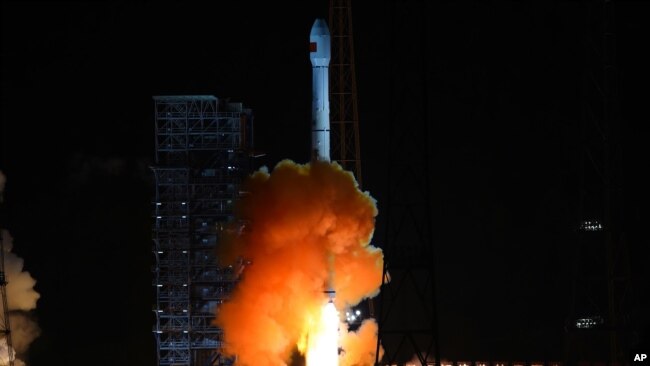予期せぬ月へのロケットブースター衝突、それはChang’e 5-T1のもの
何はともあれ、日本の宇宙開発の遅れが目立ちます!!
これはすべての分野に於いても言えるのこと。
どんな国家を築こうとしているのか、その目標もないまま進む国。
そんなことを思ってしまいました。
さぁ、今日もVOAで英語を学びましょう!!
宇宙専門家 :月面に衝突するロケットの誤認識(和訳)
Space Experts: Rocket on Path to Hit Moon Misidentified
Feb 22,2022
今月初め、3月上旬に月に衝突する可能性のあるロケットブースターの情報をお伝えしました。その報告以来、この物体を最初に観測した宇宙専門家は、ブースターの識別を誤っていたと述べています。
このブースターは最初、2015年に気候衛星の展開に役立ったSpaceXのファルコン9ロケットから残されたものだと考えられていました。現在は、2014年に打ち上げられた中国のロケットのブースターであると考えられています。
ブースターの軌道は、アメリカの天文学者ビル・グレイ氏によって初めて観測されました。彼は、アメリカ北部のメイン州に拠点を置くProject Plutoプロジェクト・プルートの生みの親です。彼は、宇宙ゴミとして知られる残骸を含むさまざまな宇宙物体の軌道を追跡できるソフトウェアを開発・販売しています。
グレイ氏によれば、すべてのデータから、ロケットは3月4日に月の裏側(地球から遠い側)に衝突することがわかるといいます。彼はブースターを特定し、その進路を綿密に追跡したことで広く注目されました。しかし、グレイ氏は最近、新しい証拠によって、彼の特定が正しくない可能性が高いことが示されたと述べています。
グレイ氏は自身のウェブサイト上の声明で、「われわれは今、それが実際に2014-065B、Chang’e5-T1ルナミッションのブースターであることを示す良い証拠を得た」と述べています。Chang’e5-T1は、2014年10月に月を一周して地球に帰還するテストミッションに送られたロボット宇宙船です。
グレイ氏は2015年に最初の特定を行いました。彼は、SpaceX社のブースターが "打ち上げから2日後の2015年2月13日に月の近くを通過した "という証拠に基づくものだと説明しました。
グレイ氏は、アメリカの宇宙機関NASAに勤めるジョン・ジョルジーニ氏からメールを受け取った後、ブースターの特定を改めて検討し始めたといいます。NASAのジェット推進研究所(JPL)のエンジニアであるジョルジーニ氏は、NASAの追跡データを調べ、SpaceXのロケットが月の近くを通過していないことを示唆していると述べたのです。
そこでグレイ氏は、以前の観測を再考し、最新の証拠に目を通しました。彼は、最初の識別が誤っているように見えると判断しました。現在、グレイ氏は、この物体がChang’e5号T1宇宙船のロケットブースターであることを事実上”信じて”いるといいます。
ブースターが月に衝突することは、天体物理学センターのジョナサン・マクダウェル氏によっても確認されています。彼はTwitterでこの誤認に反応しました。
「月に衝突しようとしているロケットは、我々が思っていたものとは違うことが判明したわけです 」と彼は書いています。「これ(正直な間違い)は、これらの深宇宙天体の適切な追跡の欠如の問題を強調しただけです。」
アリゾナ大学の研究者達は、最近、ブースターが中国のロケットから来た可能性が最も高いことを確認したとも発表しました。同大学の宇宙領域認識研究所のチームは、物体の構成と塗装を綿密に観察することによって、その正体を確認したと述べました。
NASAもまた、予想される衝突を確認しています。宇宙機関の広報担当者は、フランス通信社(AFP)に対し、この出来事は”エキサイティングな研究機会”になり得ると語ります。彼女は、NASAが衝突によって作られると予想されるクレーターを研究することに興味があると言っています。しかし、広報担当者は、それは困難なプロセスになる可能性が高く、クレーターを見つけるために”数週間から数ヶ月”かかるかもしれないと付け加えています。
過去には、科学実験のために宇宙船が意図的に月に衝突したことがあります。しかし、このように計画外の衝突が確認されたのは今回が初めてと思われます。
Space Experts: Rocket on Path to Hit Moon Misidentified
Earlier this month, we reported on a rocket booster that is on a path to strike the moon in early March. Since that report, the space expert who first observed the object has said the booster was misidentified.
It was first thought that the booster was left over from a SpaceX Falcon 9 rocket used to help deploy a climate satellite in 2015. Now, it is believed to be a booster from a Chinese rocket launched in 2014.
The path of the booster was first observed by American astronomer Bill Gray. He is the creator of Project Pluto, based in the northern U.S. state of Maine. He develops and sells software that can track the path of different space objects, including leftover ones known as space junk.
Gray says all his data shows that the rocket will hit the far side of the moon – the side that faces away from Earth – on March 4. He received wide attention for identifying the booster and closely tracking its path. But Gray recently said new evidence had shown that his identification was most likely not correct.
“We now have good evidence that it is actually 2014-065B, the booster for the Chang’e 5-T1 lunar mission,” Gray said in a statement on his website. Chang’e 5-T1 was a robotic spacecraft sent on a test mission to circle the moon and return to Earth in October 2014.
Gray made his first identification back in 2015. He explained that it was based on evidence that the SpaceX booster had “passed close by the moon on February 13, 2015, two days after it was launched.”
Gray said he started taking another look into the booster’s identify after receiving an email from Jon Giorgini, who works for the American space agency NASA. Giorgini, an engineer with NASA’s Jet Propulsion Laboratory (JPL), had examined NASA tracking data and said it suggested the SpaceX rocket did not pass close to the moon.
So, Gray reconsidered his earlier observations and looked at the latest evidence. He decided that his first identification did seem to be incorrect. Now, Gray says he is effectively “persuaded” that the object is a rocket booster from the Chang’e 5-T1 spacecraft.
The booster’s expected strike on the moon has also been confirmed by astrophysicist Jonathan McDowell of the Center for Astrophysics. He reacted to the misidentification on Twitter.
“So, the rocket about to hit the Moon, it turns out, is not the one we thought it was,” he wrote. “This (an honest mistake) just emphasizes the problem with lack of proper tracking of these deep space objects.”
Researchers at the University of Arizona recently announced they had also confirmed the booster most likely came from the Chinese rocket. The team – from the university’s Space Domain Awareness laboratory – said it confirmed the identity by closely observing the object’s composition and paint.
NASA has also confirmed the expected strike. A spokeswoman for the space agency told the French Press Agency, AFP, that the event can be “an exciting research opportunity.” She said NASA is interested in studying the crater expected to be created by the hit. But the spokeswoman added that that is likely to be a difficult process and it could take “weeks to months” to find the crater.
In the past, spacecraft have been crashed into the moon on purpose for scientific experiments. But this is likely the first unplanned strike to be identified in this way.
Words in This Story
boost – v. to push or shove up from below
track – v. to record the progress of development of something
mission – n. an important project or trip, especially involving space travel
persuade – v. to make someone agree to do something by presenting arguments and evidence
emphasize – v. to show that something is especially important or needs special attention
proper – adj. correct or suitable
composition – n. the parts, substances and other things that something is made of
opportunity – n. a situation in which it is possible for a person to do something
crater – n. a round hole made by an explosive force such as a bomb or an object falling from the sky
中国の月探査機、Chang’e-5 嫦娥(じょうが)5号
2020年12月1日に嵐の大洋(兎(うさぎ)が餅(もち)を搗(つ)く臼(うす)の部分)の北部、Rümker(リュムカー)山の北東約170km、露の入江に近い北緯43.06度、西経51.92度に着陸し(図1)、地質試料の採集などを行って、2020年12月16日に内モンゴルの沙漠に帰還した。
